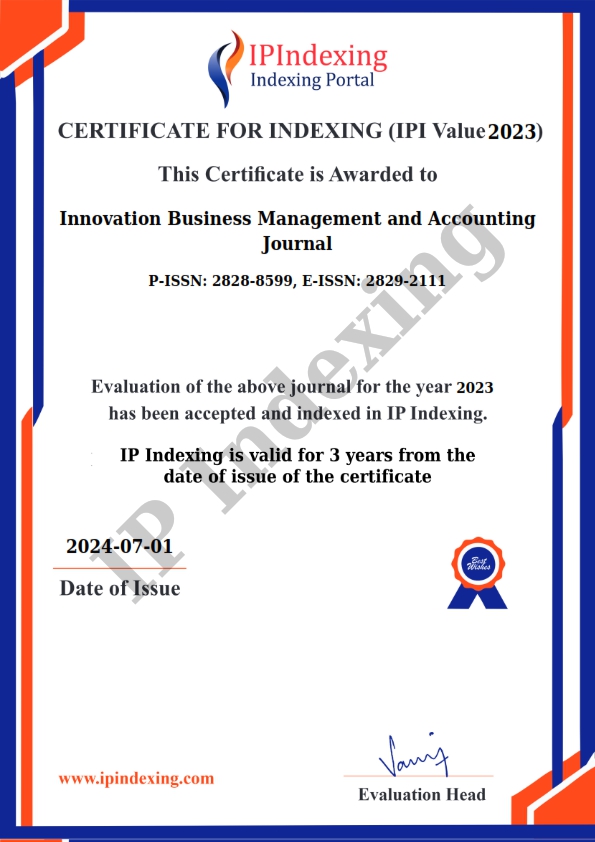The Role of Motivation, Discipline, and Work Environment in Improving Members' Performance
DOI:
https://doi.org/10.56070/ibmaj.2024.013Keywords:
Discipline, Motivation, Performance, Work EnvironmentAbstract
This study aims to analyze the impact of motivation, work discipline, and work environment on the performance of Pusdik Hanudnas Surabaya members. The study was carried out at the Surabaya Hanudnas Education Center, with a total of 70 respondents comprising non-commissioned officers and officers. This is census research. The analytical method uses several linear regression analysis techniques to determine the impact of the dependent variable (X) on the independent variable (Y). The study shows that motivation, work discipline, and work environment significantly influence the performance of employees at Surabaya Hanudnas Education Center. Motivation, work discipline, and a responsive work environment positively affect member performance by ensuring timely completion of tasks, with the work environment being the most significant factor and having the most impact on member performance. Quality, quantity, motivation, discipline, and the work environment all significantly influence the success of Pusdik Hanudnas Surabaya members. The research aims to provide valuable insights for practitioners and the Surabaya Hanudnas Education Center regarding how members' attitudes towards motivation variables, work discipline, and work environment impact performance. It can also serve as a reference for implementing strategic measures to enhance the performance of Hanudnas Pusdik members in Surabaya.
Downloads
References
Adha, R. N., Qomariah, N., & Hafidzi, A. H. (2019). Pengaruh motivasi kerja, lingkungan kerja, budaya kerja terhadap kinerja karyawan dinas sosial kabupaten Jember. Jurnal Penelitian IPTEKS, 4(1), 47-62. https://doi.org/10.32528/ipteks.v4i1.2109
Afandi, P. (2016). Human Resource Management (Theory, Concepts and Indicators). Zanafa Publishing.
Amir, M. T. (2016). Educational Innovation Through Problem-Based Learning. PT Fajar Interpratama Mandiri
Araswati, V. S. (2012). Penggunaan Metode Bermain Peran Sebagai Upaya Meningkatkan Komunikasi Pada Anak TK Indriyasana 03 Nglinggi Kelompok A Tahun Pelajaran 2011/2012 (Doctoral dissertation, Universitas Muhammadiyah Surakarta).
Ghozali, I. (2021). Multivariate Analysis Applications Using the IBM SPSS 26 Program, Edition 10. Badan Penerbit Universitas Diponegoro.
Košičiarová, I., Kádeková, Z., & Štarchoň, P. (2021). Leadership and motivation as important aspects of the international company’s corporate culture. Sustainability, 13(7), 3916. https://doi.org/10.3390/su13073916
Mansaray, H. E. (2019). The role of human resource management in employee motivation and performance-An overview. Budapest International Research and Critics Institute (BIRCI) Journal, 2(3), 183-194. https://doi.org/10.33258/birci.v2i3.405
Rizki, V. L., & Sulistyan, R. B. (2022). Manajemen Sumber Daya Manusia. Widya Gama Press.
Sedarmayanti. (2017). Perencanaan dan Pengembangan SDM untuk Meningkatkan Kompetensi, Kinerja, dan Produktivitas Kerja. Penerbit PT. Refika Aditama.
Sinambela, L. P. (2018). Human Resource Management. PT Bumi Aksara.
Sulistyan, R. B. (2017). Kontribusi Kepemimpinan dan Lingkungan Kerja dalam Meningkatkan Motivasi Pegawai. Jurnal Ilmu Manajemen Advantage, 1(2), 166-177. https://doi.org/10.30741/adv.v1i2.196
Sulistyan, R. B. (2018). Kondisi Lingkungan Pekerjaan Sebagai Ukuran Kesetiaan Pada Organisasi. Wiga : Jurnal Penelitian Ilmu Ekonomi, 8(1), 32-41. https://doi.org/10.30741/wiga.v8i1.234
Sutrisno, E. (2016). Human Resources Management. Prenadamedia Group.
Wibowo, (2016). Performance Management. PT. Rajagrafindo Persada.
Wilson, B. (2012). Human Resource Management. Penerbit Erlangga.
Downloads
Published
How to Cite
Issue
Section
License
Copyright (c) 2024 Sugeng Sugiharto, Boge Triatmano, Sina Setyadi

This work is licensed under a Creative Commons Attribution-ShareAlike 4.0 International License.



